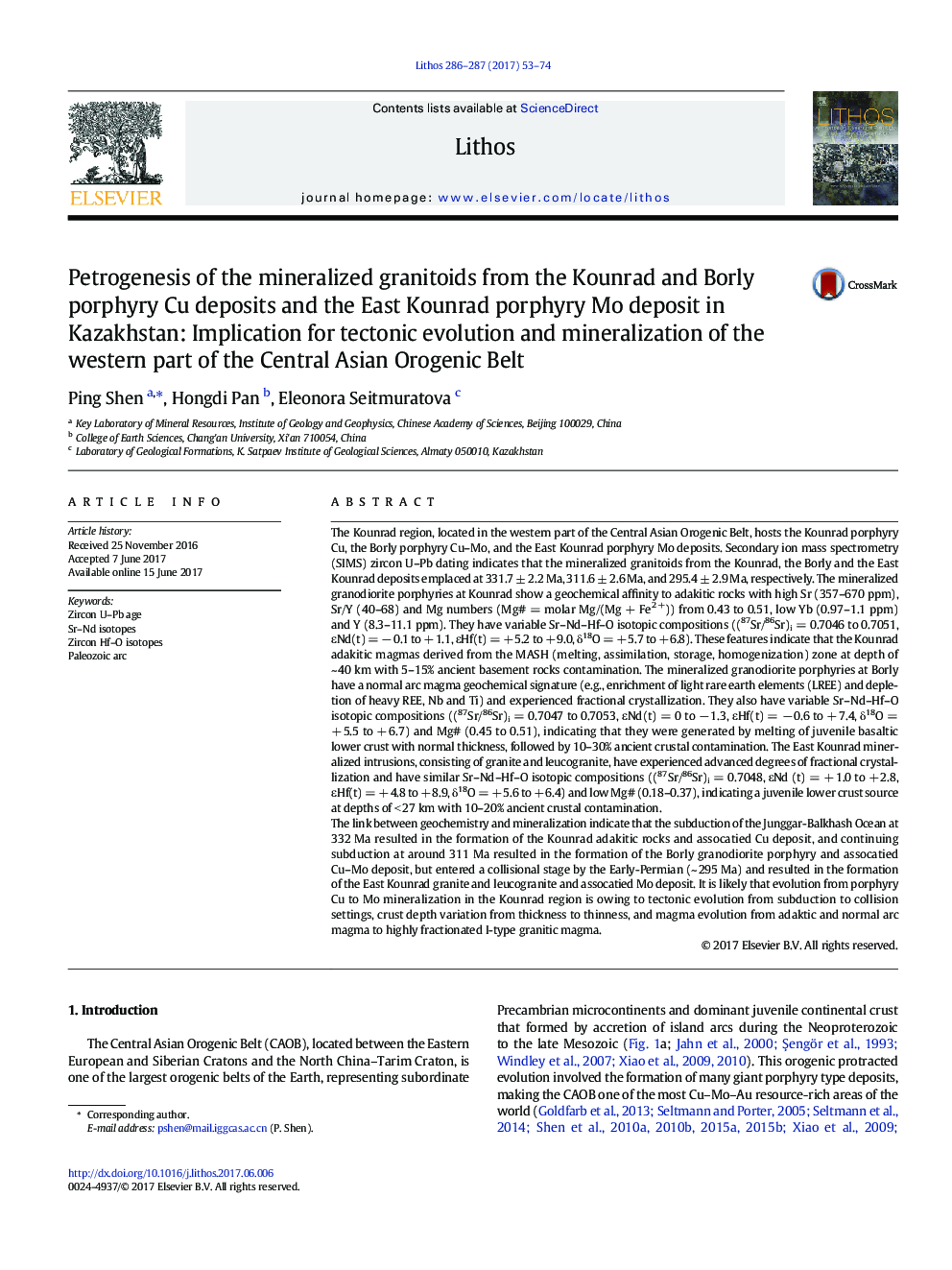| Article ID | Journal | Published Year | Pages | File Type |
|---|---|---|---|---|
| 5784220 | Lithos | 2017 | 22 Pages |
Highlightâ¢Intrusions emplaced at 332 Ma (Kounrad), 312 Ma (Borly) and 295 Ma (East Kounrad).â¢Kounrad adakitic rocks were produced by partial melting of MASH zone at depth of ~ 40 km.â¢Borly and East Kounrad mineralized magma derived from the juvenile thin lower crustâ¢Tectonics evolved from subduction to collision and mineralization from Cu to Mo.
The Kounrad region, located in the western part of the Central Asian Orogenic Belt, hosts the Kounrad porphyry Cu, the Borly porphyry Cu-Mo, and the East Kounrad porphyry Mo deposits. Secondary ion mass spectrometry (SIMS) zircon U-Pb dating indicates that the mineralized granitoids from the Kounrad, the Borly and the East Kounrad deposits emplaced at 331.7 ± 2.2 Ma, 311.6 ± 2.6 Ma, and 295.4 ± 2.9 Ma, respectively. The mineralized granodiorite porphyries at Kounrad show a geochemical affinity to adakitic rocks with high Sr (357-670 ppm), Sr/Y (40-68) and Mg numbers (Mg# = molar Mg/(Mg + Fe2 +)) from 0.43 to 0.51, low Yb (0.97-1.1 ppm) and Y (8.3-11.1 ppm). They have variable Sr-Nd-Hf-O isotopic compositions ((87Sr/86Sr)i = 0.7046 to 0.7051, εNd(t) = â 0.1 to + 1.1, εHf(t) = + 5.2 to + 9.0, δ18O = + 5.7 to + 6.8). These features indicate that the Kounrad adakitic magmas derived from the MASH (melting, assimilation, storage, homogenization) zone at depth of ~ 40 km with 5-15% ancient basement rocks contamination. The mineralized granodiorite porphyries at Borly have a normal arc magma geochemical signature (e.g., enrichment of light rare earth elements (LREE) and depletion of heavy REE, Nb and Ti) and experienced fractional crystallization. They also have variable Sr-Nd-Hf-O isotopic compositions ((87Sr/86Sr)i = 0.7047 to 0.7053, εNd(t) = 0 to â 1.3, εHf(t) = â 0.6 to + 7.4, δ18O = + 5.5 to + 6.7) and Mg# (0.45 to 0.51), indicating that they were generated by melting of juvenile basaltic lower crust with normal thickness, followed by 10-30% ancient crustal contamination. The East Kounrad mineralized intrusions, consisting of granite and leucogranite, have experienced advanced degrees of fractional crystallization and have similar Sr-Nd-Hf-O isotopic compositions ((87Sr/86Sr)i = 0.7048, ÉNd (t) = + 1.0 to + 2.8, εHf(t) = + 4.8 to + 8.9, δ18O = + 5.6 to + 6.4) and low Mg# (0.18-0.37), indicating a juvenile lower crust source at depths of < 27 km with 10-20% ancient crustal contamination.The link between geochemistry and mineralization indicate that the subduction of the Junggar-Balkhash Ocean at 332 Ma resulted in the formation of the Kounrad adakitic rocks and assocatied Cu deposit, and continuing subduction at around 311 Ma resulted in the formation of the Borly granodiorite porphyry and assocatied Cu-Mo deposit, but entered a collisional stage by the Early-Permian (~ 295 Ma) and resulted in the formation of the East Kounrad granite and leucogranite and assocatied Mo deposit. It is likely that evolution from porphyry Cu to Mo mineralization in the Kounrad region is owing to tectonic evolution from subduction to collision settings, crust depth variation from thickness to thinness, and magma evolution from adaktic and normal arc magma to highly fractionated I-type granitic magma.
Graphical abstractDownload high-res image (277KB)Download full-size image
